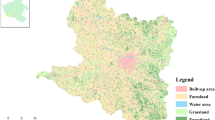Abstract
The quantitative evaluation of water conservation in the Luoyang area can provide a basis for decision-making on regional water resources development and utilization, ecological environmental protection, and economic development planning. Based on the SWAT model and alternative engineering method, the water conservation and its service value in Luoyang region from 2009 to 2018 were assessed and the reasons for their spatial and temporal changes were analyzed. The results show that during the period of 2009–2018, the total water connotation and its service value reached the highest in 2014, with 16,927,100 m3 and 103 million yuan, respectively; the total water connotation and its service value reached the lowest in 2011, with 7,073,500 m3 and 43,224,000 yuan, respectively. Forest ecosystems have a strong water retention and storage capacity, and the highest water conservation and service value. Precipitation is the most important factor influencing water conservation and service value. The value of water-supporting services per unit area of ecosystem in Luoyang area is forest, grassland, arable land, and urban in descending order.









Similar content being viewed by others
Availability of data and materials
Datasets and other materials are available with the authors and may be accessible at any time upon request.
References
Anderson, S. J., Ankor, B. L., & Sutton, P. C. (2017). Ecosystem service valuations of South Africa using a variety of land cover data sources and resolutions. Crossref, 27, 173–178.
Arabi, M., Rao, S., Mohamed, M., et al. (2006). Role of watershed subdivision on modeling the effectiveness of best management practices with SWAT. Journal of the American Water Resources Association, (4), 513–528.
Bagstad, K. J., Semmens, D. J., Waage, S., et al. (2013). A comparative assessment of decision-support tools for ecosystem services quantification and valuation. Crossref, 5, 27–39.
Bao, Y. B., Li, T., Liu, F., et al. (2016). Spatial and temporal variation of water conservation function in the Loess Plateau of northern Shaanxi based on InVEST model. Geography Research, 35(4), 664–676.
Costanza, R., Atkins, P. W., Bolton, M., et al. (2017). Overcoming societal addictions: What can we learn from individual therapies?. Crossref, 131, 543–550.
Dai, J. F., & Cui, Y. L. (2009). Distributed hydrological model of irrigation area based on SWAT -I. Principles and methods of model construction. Journal of Water Resources, 40(02), 145–152.
Dou, H., Li, X., Li, S., et al. (2020). Mapping ecosystem services bundles for analyzing spatial trade-offs in Inner Mongolia, China. Crossref, 256, 120444.
Gong, F., Luo, Y., Tian, H., et al. (2020). Assessment of the importance of the water-conserving function in the dam area of Zhangjiakou. Grassland Science, 37(7), 1337–1344.
Gong, S., Xiao, Y., Zheng, H., et al. (2017). Spatial characteristics of water conservation of Chinese ecosystems and their influencing factors. Journal of Ecology, 37(7), 2455–2462.
Lin, F., Chen, X. W., Yao, W. Y., et al. (2020). Multi-timescale analysis of water conservation in watersheds with discontinuous forest distribution based on SWAT model. Journal of Geography, 75(5), 1065–1078.
Liu, J., Fu, B., Zhang, C., et al. (2019). Assessment of water conservation and value of the upper Minjiang River ecosystem based on the InVEST model. Yangtze River Basin Resources and Environment, 28(3), 577–585.
Liu, S. R., Chang, J. G., & Sun, P. S. (2007). Forest hydrology: Forest-water relationships in the context of global change. Journal of Plant Ecology, 31(5), 753–756.
Ouyang, Z. Y., Zhao, T. Q., Wang, X. K., & Miao, H. (2004). Analysis of water ecological service function and its indirect value evaluation. Acta Ecology, (10), 2091–2099.
Qiao Fei, Fu., Xiangqin, G. X., et al. (2018). Assessment of water connotation function in Sanjiangyuan District. Environmental Science Research, 31(6), 1010–1018.
Shanshan, C., Kang, L., Yubin, B., et al. (2016). Spatial pattern of water connotation service function and influencing factors in Shangluo City. Geoscience, 36(10), 1546–1554.
Tang, Y., Zhu, W., Zhang, H., et al. (2015). Research progress on the principle of InVEST model and its application. Ecological Science, 34(3), 204–208.
Wang, C. G., Liu, C. M., & Huang, Y. B. (2003). Research on the principle, structure and application of SWAT model. Advances in Geographical Sciences, 01, 79–86.
Wang, Y., Xu, P., Fu, B., et al. (2018). Research progress of water conservation function assessment model of forest ecosystem. Ecological Economics, 34(2), 158–164.
Xiao, Y., Xie, G., Lu, C., et al. (2005). The value of gas exchange as a service by rice paddies in suburban Shanghai, Pr China. Crossref, 109(3), 273–283.
Xie, G., Lu, C., & Cheng, S. (2001). Advances in global ecosystem service valuation. Resource Science, 06, 5–9.
Zhang, B., Li, W., Heights, X., et al. (2009). Water-holding function of forest ecosystems and its measurement method. Journal of Ecology, 28(3), 529–534.
Author information
Authors and Affiliations
Contributions
Zhang XQ: methodology, investigation, writing-original draft preparation. Chen P: conceptualization, writing-review and editing. Dai SN: methodology, formal analysis. Han YH: conceptualization, writing-original draft preparation.
Corresponding author
Ethics declarations
Ethical approval
This paper does not contain any studies with human participants or animals performed by any of the authors.
Consent to participate
Consent.
Consent to publish
Consent.
Competing interests
The authors declare no competing interests.
Additional information
Publisher's Note
Springer Nature remains neutral with regard to jurisdictional claims in published maps and institutional affiliations.
Rights and permissions
About this article
Cite this article
Zhang, X., Chen, P., Dai, S. et al. Assessment of the value of regional water conservation services based on SWAT model. Environ Monit Assess 194, 559 (2022). https://doi.org/10.1007/s10661-022-10247-w
Received:
Accepted:
Published:
DOI: https://doi.org/10.1007/s10661-022-10247-w




